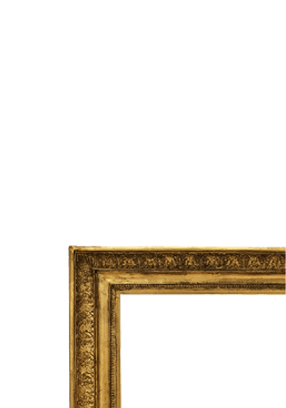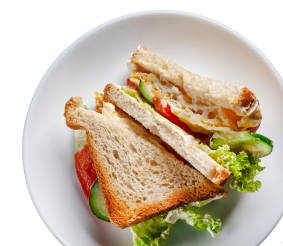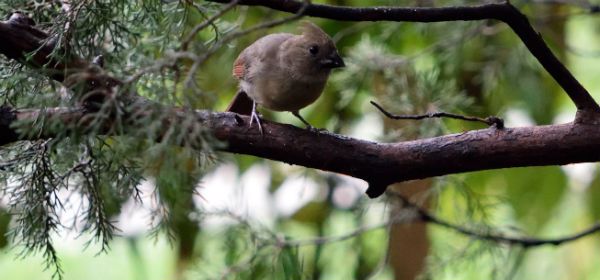Attracting backyard birds
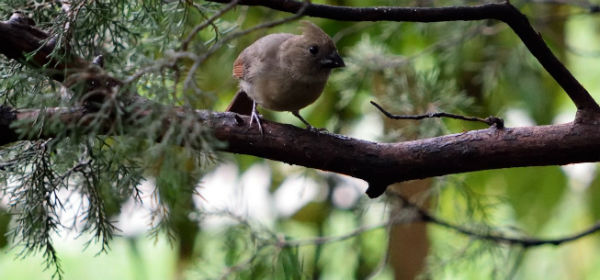
Photo of juvenile cardinal/courtesy of Kim Sain
Continue enjoying the outdoors after the weather drives you indoors for the winter by attracting birds outside your windows. If you feed them, they will come, and you’ll be surprised how entertaining it can be to watch the parade of birds at your bird feeders. To get an idea, take a look below at the Cornell Lab of Ornithology's live FeederWatch Cam. (Please note that because it is a live cam the level of activity will vary.)
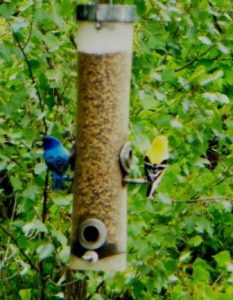
Indigo Bunting and Goldfinch on our finch feeder.
Feed the birds
It doesn’t take a big investment in time, money or knowledge to get started feeding the birds. Once you get started, you can add different types of feeders and food to attract different birds. After a while, you learn the patterns and habits of different birds, and that just adds to the fun. I see different birds at different times of year and at different times of day. Every spring I look forward to the arrival of the Indigo Buntings. They are so bright and lovely. My very favorite combination of birds at my feeder is Indigo Buntings and Goldfinches. The bright blue and yellow birds together become a beautiful gift for my eyes!
Provide water
Adding a birdbath or water feature is a great enticement for feathered visitors. Their antics will have you laughing out loud!
Habitat and home
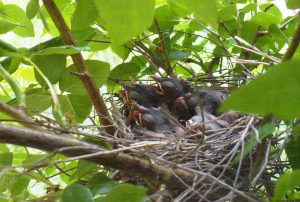
Hungry baby Cardinal's in a nest in my rose bush.
You can also make landscaping choices that provide habitat and protection for birds. You can install nest boxes or birdhouses. If you do this, you will likely have the opportunity to enjoy watching families grow!
Bird safety
There are some risks to backyard birds. One common problem is that birds will injure themselves by flying into glass windows. This happens because the windows reflect an image of the outside. There are a couple of ways to avoid this. One is to place decals or something similar on the glass that will let the birds know that this is not the great outdoors. Another remedy is to place the bird feeders close enough that the birds won’t build up too much speed if they fly toward the windows.
Another risk is predators. These can be wild predators such as hawks or “tame” predators such as cats. This is where your landscaping choices come into play. You can landscape in a way that provides some shelter for birds from hawks – and in a way that doesn’t provide hiding places for cats.

Yellow Rumped Warbler photo courtesy of Josiah Legler
Other benefits
The birds you attract to your yard will likely chow down on garden pests as well as on bird seed. If you are a gardener, you may notice a decrease in the number of pests chewing on your beloved plants. When you start gardening for the birds you will likely make choices that are good for the environment such as using organic materials and native plants.
Attracting birds may very well help the whole species – not just the birds in your backyard. As with other animals and species, civilization encroaches on bird habitats and food sources. Some bird species have been saved from extinction because birders have nurtured them through difficult winters and/or installed nest boxes for them. This was the case for Bluebirds, which hovered on the brink of extinction until their plight was publicized in National Geographic in 1977. Hundreds of thousands of nest boxes were erected across the country, and populations are now stable for Eastern, Western and Mountain Bluebirds.
Some people will tell you that if you feed the birds you teach them to depend on you and that they will suffer if you stop feeding them. However, studies have shown that birds usually only get about 25 percent of their food from feeders and easily shift back to finding their own natural sources for food when the feeding stops.
There are some really good resources to help you, such as the Cornell Lab of Ornithology's All About Birds website mentioned above. The National Audubon Society also has some excellent online resources. We have a well-rounded selection of books about attracting backyard birds. Here is a list of some of my favorites:
View complete list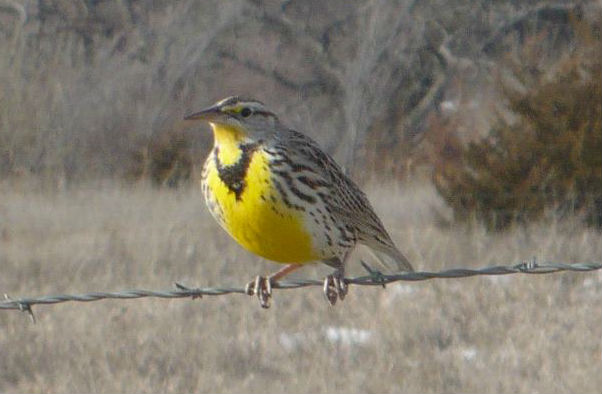
Meadowlark photo courtesy of Josiah Legler





